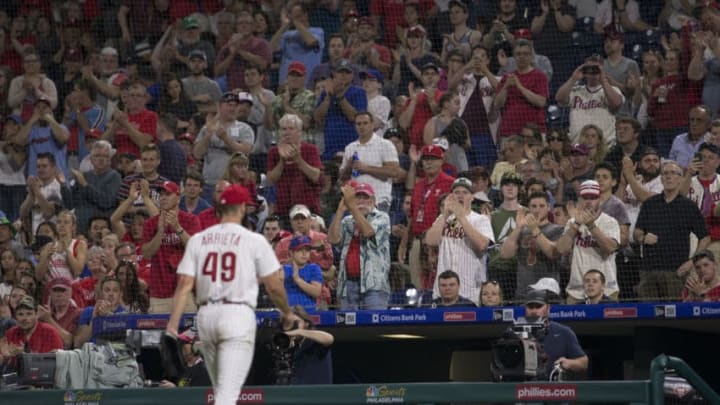After a miserable April in weather, MLB attendance was a worry, but now that time has passed, are those worries still present?
Back in late May Call to the Pen raised a question about MLB attendance. Was the drop year-over-year from 2017 merely a matter of a miserable spring? At that time the seats to be filled mostly weren’t, but it had been a truly cold spring in the Northeast and upper Midwest.
At that time there seemed no real rhyme or reason to the lists of teams doing well and teams doing badly. Ordinarily strong or improved teams were down and up in attendance (Boston versus New York Yankees). Usually bad or worse teams were up and down (Oakland versus Cincinnati). However, in all only eleven of the thirty MLB teams had more people in available home seats as of May 20 against the year before.
Since the All-Star break has now arrived, and the weather is extremely pleasant almost everywhere in the country, range fires and thunderstorms notwithstanding, maybe it’s time to take stock again. On May 20 overall MLB attendance was down an average of 2021 fans a game.
There’s now good news, but a little more bad news. The good news is warm weather sends more people to baseball games. MLB attendance has picked up (through 7/15) an average of 286 people a game. Part of the bad news is this isn’t very many more people a game, and overall attendance is still down 1,735 a game since 2017.
Perhaps more significantly bad news is the total of teams with improved home attendance over 2017 has dropped in about two months from 11 to nine.
Three teams “in the black” May 20, the Angels, Athletics and Rockies, have fallen off that list. Only the Philadelphia Phillies, the surprise NL East leader, have an improved attendance per game over 2017 now, but didn’t on May 20.
Poking a little at those numbers, not even digging, yields more arguably bad news, most significantly the Athletics falling to minus-2652 fans a game despite improving their record from three games over .500 to 13 games over .500. Philadelphia is only 11 over .500. Likewise, the Rockies improved their record, or at least kept pace, moving from three over to six over. The Angels are also over .500, but fell off the list.
The MLB attendance improvement leader at the moment is Milwaukee, drawing 5709 more fans a game and closing in fast on plus-300 thousand for the year. However, the declining attendance “top teams” are Miami, which has dropped a somewhat predictable 11,411 per game after one of their famous fire sales, and Toronto, which has dropped 10,672. At the All-Star break, both teams are over half a million fans worse than 2017.
Not Even Really Digging Continued
Poking a little at the Phillies, the one team moving into positive-attendance territory, exposes a problem number and hints at the reasons for the MLB attendance drop. Despite moving from second to first place in their division in a two-month stretch, the Fightin’s are only in the black by 825 fans at home (versus minus-1600 on May 20).
Why? Let’s suggest a couple of matters beyond the universal growth in defensive shifts mentioned in May. First, the Phillies walk a lot. They are third in baseball at the moment to the Cubs and Reds with 3.85 walks per game, 0.80 a game more than 2017, and a much bigger jump than the Cubs’ and Reds’ increase year-over-year. Walks are boring to watch, and at home the Phillies walk even more – 4.34 times a game.
More from Call to the Pen
- Philadelphia Phillies, ready for a stretch run, bomb St. Louis Cardinals
- Philadelphia Phillies: The 4 players on the franchise’s Mount Rushmore
- Boston Red Sox fans should be upset over Mookie Betts’ comment
- Analyzing the Boston Red Sox trade for Dave Henderson and Spike Owen
- 2023 MLB postseason likely to have a strange look without Yankees, Red Sox, Cardinals
Second, Philadelphia is next to last at putting the bat on the ball, striking out 9.51 times a game. They’re a little better at home (8.75 Ks per game). Obviously, watching strikeouts is also not very exciting.
Walks and strikeouts also slow baseball down, and it is no surprise the Phillies tied the MLB record this year for the longest ever nine-inning game – four hours, 30 minutes. In that longest standard game July 6, the Philadelphia Phillies walked 10 times, and their hitters struck out 12 times, in spite of scoring 17 runs.
Nonetheless, the Philadelphia and national media often refer to the Phillies as “an exciting young team” (see the poll midway through the article). It would be more accurate to say they’re young and somewhat efficient, winning with starting pitching and dribbling runs to home plate except for an occasional outburst.
Next: Relief Roundup: Dozier's grand walk off
So, the news on MLB attendance is not great, but it’s not ALL bad, either. We will have to look again at the end of the season to see how this all plays out.
